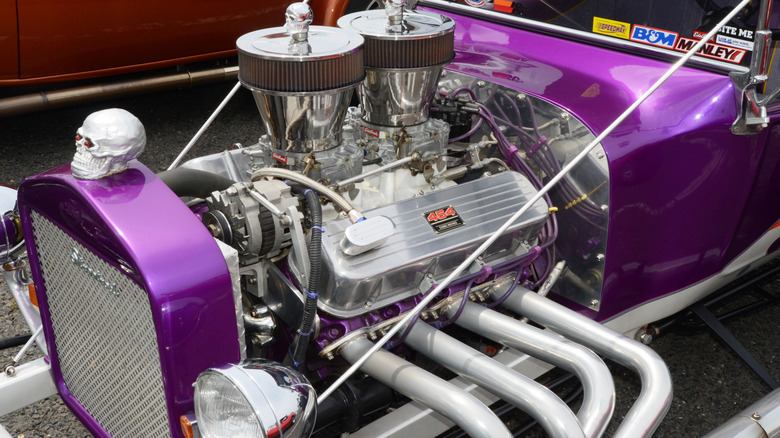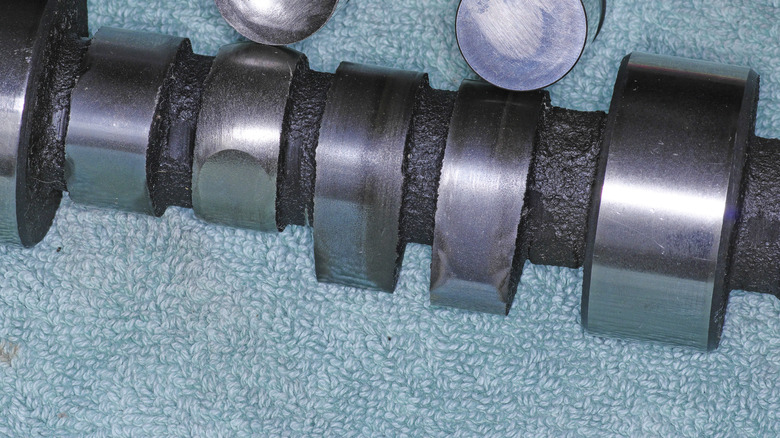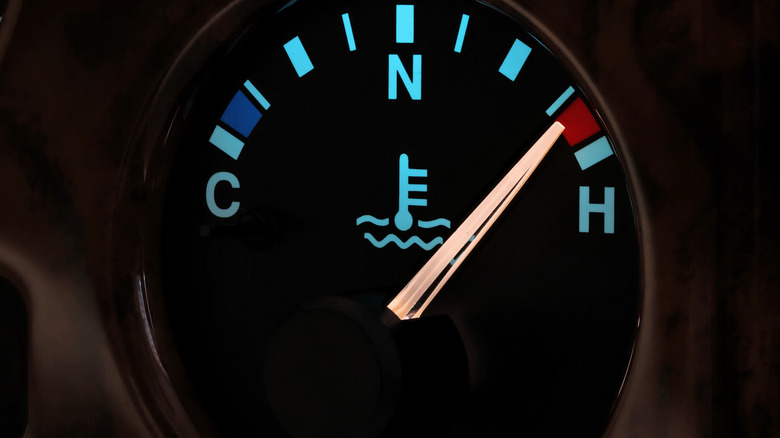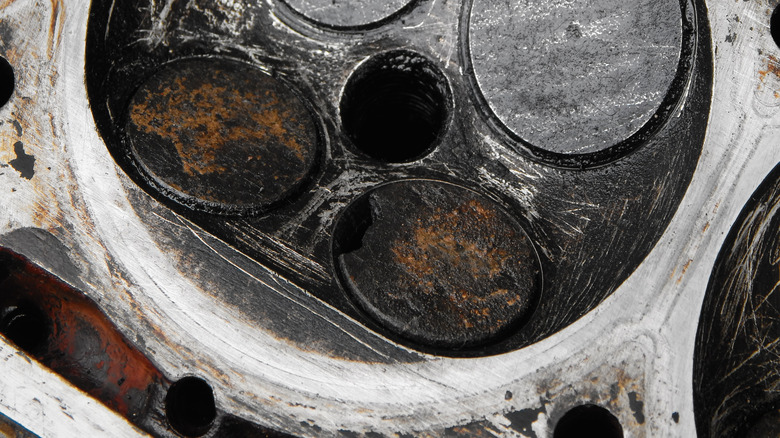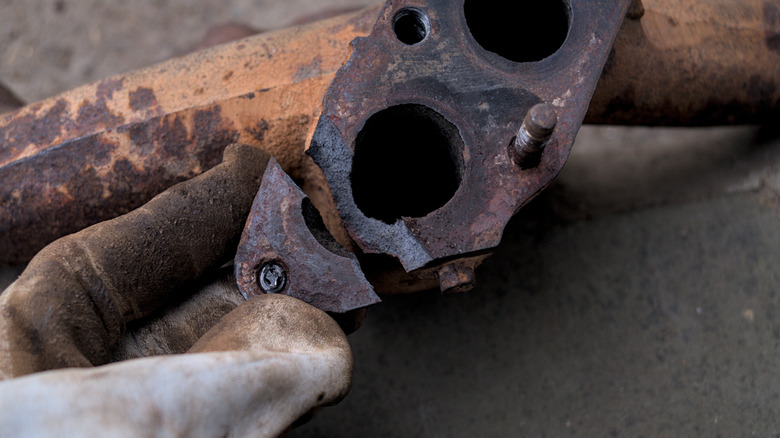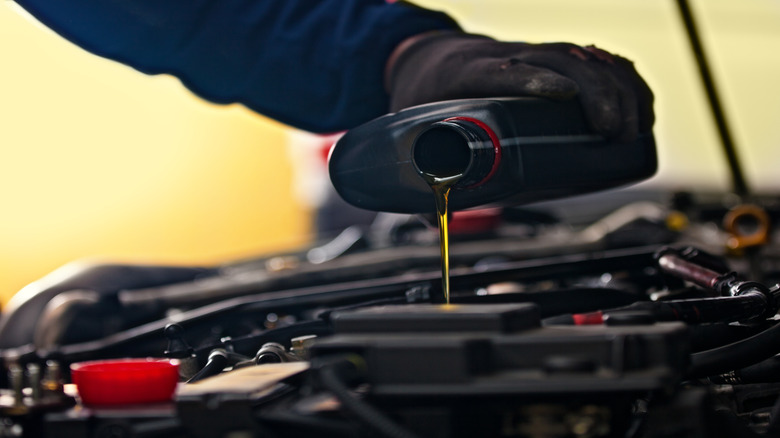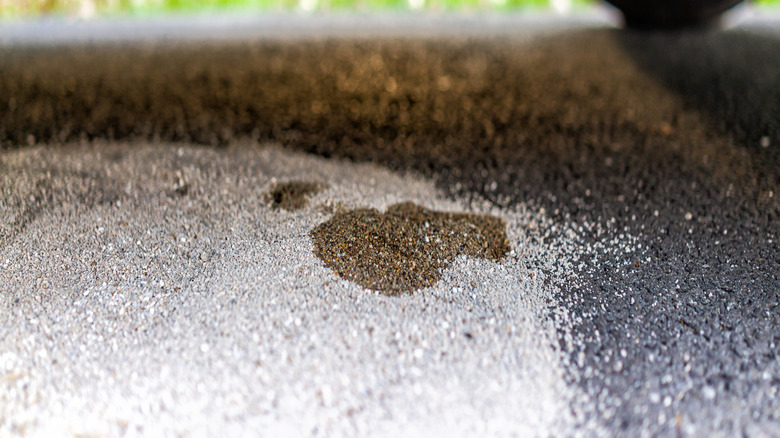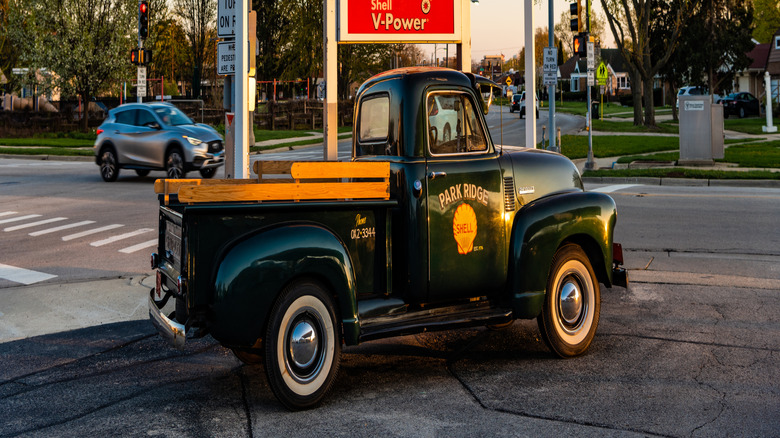8 Of The Most Common Problems With Chevy Big Block Engines
"There's no replacement for displacement!" This has been the battle cry of big block fans everywhere, and for good reason. A Chevy big block brings the thunder, whether you're roasting tires with a rowdy 454 or towing your toys in an 8.1L Vortec-powered rig.
However, let's get one thing straight — these engines aren't for the faint of heart. They're for those who measure fun in tire smoke, judge music by cam lope, and consider "fuel economy" a dirty phrase. Still, for every grin-inducing pull, there's a matching moment of frustration that'll make you curse the day you fell for cubic inches.
Maybe it's bent pushrods that leave you stranded miles from home, or it's the backfiring through the carb that has you keeping a fire extinguisher within arm's reach. Perhaps it's the rear main seal that treats oil leakage as its life's mission despite being replaced three times. The list goes on, and big block life means being ready for whatever pops up next.
So whether you're buying a numbers-matching Corvette, thinking about an engine swap, or just keeping your tow rig alive, it helps to know what Chevy big block problems possibly await. Let's walk through the biggest headaches so you can decide if it's worth the extra muscle.
Bent pushrods
One of the more common Chevy big block problems that'll ruin your day is a bent pushrod. These slim rods are supposed to transfer motion from the cam to the valve — a simple job, right? In a big block world, however, nothing's ever that easy.
All it takes is a weak valve spring, improper lash, or a failed lifter to send the pushrods off course. The problem is especially common in high-RPM applications where valve float can occur. If you've ever flubbed a downshift and spiked the revs — hello, money shift — you're flirting with disaster. A sudden over-rev can slam the valvetrain out of sync and bend pushrods in an instant. Suddenly, that straight little rod looks more like a noodle than a precision part.
You'll know something's up when the engine starts misfiring or making an incessant ticking noise. Sometimes, it happens at startup, sometimes while you're cruising, and sometimes during a full-throttle pull that was going just fine — until it wasn't. If you're lucky, it's just one pushrod and no collateral damage, but it can go downhill fast if you don't catch it early. Bent pushrods can lead to deeper valvetrain carnage, and depending on the setup, that might mean pulling the heads to fix what got wrecked.
Bottom line? If your big block suddenly sounds off or runs rough, don't just crank the volume up — pop the valve covers and take a look. It might save you a much bigger headache down the road.
Cam lobe wear
Big blocks love making power, but that doesn't mean they always do it reliably. One sneaky issue that can slowly rob your performance is worn cam lobes. If you're running a flat tappet cam — and a lot of older big blocks are — you've got to play by a very specific set of rules. This means careful assembly, using zinc-rich oil, and proper break-in. Skip one of those steps, and your cam lobes can go flat in a hurry. This can result in a lobe that's no longer lifting the valve properly.
What makes cam lobe wear particularly frustrating is how it sneaks up on you. The engine will usually still run, just not well. You might notice that it sounds flat, idles rough, and feels like it left half its horsepower at home. It's easy to blame the carb or timing at first, but if you've checked everything else, don't rule out a flattened cam lobe. Catch it early, and you might be able to save the rest of the valvetrain. Let it go too long, and you're looking at metal shavings in the oil, trashed lifters, and a full teardown. Not fun.
The takeaway? If you're running a flat tappet cam in your big block, treat it like the fragile, high-maintenance performance part it is. Better yet, start budgeting for a roller setup.
Overheating
Chevy big blocks are known for running hot. It's just part of the deal when you're moving that much metal and making that much torque. Still, there's a huge difference between running warm and blowing steam on the side of the highway.
If your temp gauge keeps climbing past 195 to 210°F (depending on your setup), it's time to dig into the cooling system. A lot of overheating issues come down to basic stuff — not enough radiator, the wrong fan setup, no shroud, or pulley sizes that throw off your water pump speed. Don't forget the bypass hose between the water pump and intake — leave it out, and coolant might not circulate properly at low RPM.
When a big block overheats, it doesn't just forgive and forget. Blown head gaskets, warped heads, or even a cracked block can be the price of pushing too hard. Once that damage is done, you're not just fixing a problem. You're questioning every cooling system choice you've ever made. Worse? If you don't solve the real issue, high coolant temps will come back like a bad habit.
The moral of the story is that you've got to respect the heat. Make sure your cooling setup is built for the engine you're running, not what came stock. If your setup has a factory temperature gauge, don't rely on it too much. It might not tell the full story until it's too late. A reliable aftermarket gauge is cheap insurance when you're playing with this much iron.
Burnt exhaust valves
A healthy big block roars. One with burnt exhaust valves? Not so much. Burnt exhaust valves mess with how your engine breathes, leading to lost compression, uneven combustion, and a noticeable drop in performance. If the engine starts idling rough, struggling under load, or just doesn't pull like it used to, this could be why.
The main culprit behind burnt valves? Heat, and lots of it. Exhaust valves run in extreme conditions, often up to 450°F hotter than intake valves. When they don't seat properly, they can't transfer that heat into the cylinder head, and it starts building up right at the valve edge. Over time, that heat causes the metal to erode. Throw in a lean air/fuel mix, bad timing, or cheap low-octane gas, and this Chevy big block problem speeds up fast.
Exhaust valves don't usually fail overnight, though. Instead, the damage creeps up over time. Once it happens, though, there's no easy fix. Pulling the heads and replacing the damaged valves is in your future. If the seat's torched, too, you're looking at a full rebuild. That's why the smart move is to focus on prevention. Maintain proper engine cooling, dial in your timing and air/fuel mix, and avoid running lean under load so you can keep burning rubber — not your valves.
Backfiring through carb
If your big block is spitting fire through the carb, something's off, and it's not just your timing. Backfiring isn't just loud and jarring — it's also a bit embarrassing. It's a sign your engine's out of sync, and it can lead to real damage if ignored.
The usual suspects? Ignition timing that's too far advanced, vacuum leaks, or a faulty EGR valve. A lean air/fuel mixture can also be to blame — sometimes caused by fouled spark plugs, bad plug wires, or a weak ignition coil. Valvetrain issues are another possibility, like a sticking valve or bent pushrod that leaves the intake open at the wrong time. When that happens, raw fuel meets a spark while the intake valve's still hanging open, and boom, right back through the carb.
It's super easy to brush off a single backfire as no big deal, but if it keeps happening, it's time to track down the cause of this Chevy big block problem. Repeated backfires can damage your carb, lightly toast your air cleaner, or even start a big fire under the hood if things get sketchy enough. Consider that first backfire your final warning. The next one might come with flames and a massive repair bill. Since this kind of failure rarely gives much of a heads-up, it's not a bad idea to carry a fire extinguisher in your car at all times. It's cheap insurance for when your big block forgets it's an engine and turns into a flamethrower.
Cracked exhaust manifolds
Cracked exhaust manifolds don't always scream for attention, but they sure steal power behind your back. On a Chevy big block, those heavy cast-iron manifolds take a beating from constant heat cycles and engine vibrations. Over time, all that expansion and contraction can cause them to split, especially around bolt holes or at the collector.
The symptoms can be subtle at first — a ticking noise on cold start, a faint exhaust smell under the hood, or a slight drop in throttle response. However, as the crack grows, so does the leak, and so does the problem. On EFI setups, a pre-O2 exhaust leak can mess with your fueling. On carb setups, it's more about killing scavenging and torque. Either way, a cracked manifold is bad news.
Once the manifold cracks, it's pretty much game over. You could try to weld it, but why bother? You now have the perfect excuse to weigh the pros and cons of fresh cast iron exhaust manifolds versus headers. Spoiler alert — headers are usually worth it. Not only do full-length, long-tube headers solve the cracking issue, but they also give your big block a solid bump in performance and a more aggressive exhaust note. Just don't forget to check for warped flanges, replace the gaskets, and re-torque after heat cycling your new headers. Otherwise, you'll just trade one leak for another.
Excessive oil consumption
Some Chevy big blocks are just plain thirsty — for oil. It's not just a drip here and there, as a quart or more can disappear between oil changes, sometimes without leaving a trail of smoke or small puddles behind. Mechanical issues like worn piston rings and valve guides are the most common causes of excessive oil consumption, especially in high-mileage engines. Higher oil consumption is also normal on freshly rebuilt engines while the rings are still seating, but that should improve after a few hundred miles. If it doesn't, loose tolerances or poor machine work could be letting oil slip past the rings.
Sometimes, it's just part of the engine design. Low-tension piston rings, which are common in some crate engines or performance builds, are made to reduce friction, and as a trade-off, they naturally let a bit more oil past the rings and into the combustion chamber. This doesn't always mean something's wrong, but it does mean keeping a closer eye on the dipstick.
For a lot of drivers, burning a little oil just comes with the territory. They keep a few quarts in the trunk and move on. However, if the engine starts using more oil than usual — or you're tired of the constant top-offs — it might be time to do some testing. A leak-down or engine compression tester can tell you if there's a bigger problem hiding inside.
Leaking rear main seal
A leaking rear main seal is practically a rite of passage for big block Chevy owners. It's one of those classic problems that shows up whether the engine's old, freshly rebuilt, or somewhere in between. When it leaks, it really leaks, leaving you with drips on the driveway, a faint trail down the transmission, and that unmistakable smell of burning oil on hot exhaust.
There are a few reasons why this happens. Most commonly, age and heat break down the seal over time. However, excessive crankcase pressure can also push oil past the seal. Some older big blocks use a two-piece seal, which is notoriously tricky to install correctly and more prone to leaks than modern one-piece designs.
Technically, it's possible to replace the two-piece seal without pulling the engine, but it's no fun. You'll need to support the engine, drop the oil pan, pull the rear main cap, and carefully work the new seal into place without damaging it or the crank. Even then, success isn't guaranteed. For some owners, it's easier to live with a minor leak than go through the hassle of fixing it. If that drip turns into a pour, however — or you're just tired of topping off and cleaning up — it might be time to bite the bullet and do it right.
Poor fuel economy
Nobody buys a Chevy big block for its fuel economy. These engines were built to haul, race, or raise hell, not win efficiency awards. Still, if your fuel economy suddenly tanks or seems worse than usual, it's worth checking a few basics. For starters, a rich-running carb, bad ignition timing, or fouled spark plugs can all drag efficiency down. Vacuum leaks or a faulty oxygen sensor (on EFI setups) can also cause the engine to dump more fuel than it needs. Even mechanical stuff like dragging brakes, worn bearings, or underinflated tires can make a big block feel even thirstier than normal.
Keep in mind, though, that some setups are just built to gulp fuel. Big cams, low gearing, and oversized carbs are a blast, but there's a trade-off for all that fun, especially if you have a lead foot. The key is knowing what's normal for your setup. If the engine's running clean, the plugs look good, and everything's tuned properly, then bad mileage is just part of the deal. If the numbers drop suddenly or keep getting worse, however, it's probably more than just the nature of the beast.
Is the big block life right for you?
So is the power, sound, and street cred worth the headaches? For some folks, the answer is a loud, cammed-up "Yes!" They live for the rumble and all that comes with it. For others, especially those looking for something a bit more reserved, a big block might be more trouble than it's worth.
At the end of the day, it's all about what kind of ride you want and what you're willing to deal with to get it. If you're up for the challenge, a Chevy big block will definitely keep things interesting. So, what's it going to be? Are you ready to chase horsepower and live with the quirks, or would you rather keep things simple and skip the drama?
Don't worry. There's no wrong answer here — just the right one for your budget, appetite for chaos, and love for the road or the track. Either way, now you know what you're signing up for if you embrace the big block life.
